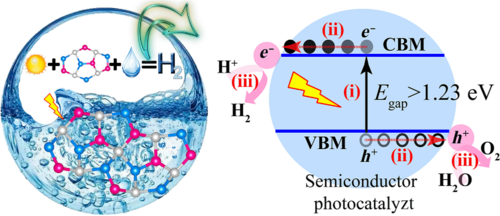Two-Dimensional Ternary Pentagonal BCN: A Promising Photocatalyst Semiconductor for Water Splitting with Strong Excitonic Effects
-
Authors :
Mehmet Emin Kilic, Kwang-Ryeol Lee
-
Journal :
Phys. Rev. Applied
-
Vol :
18
-
Page :
014066
-
Year :
2022

Abstract
Developing photocatalysts that can effectively utilize solar energy to catalyze and decompose water into hydrogen and oxygen is highly desired for sustainable and clean hydrogen energy. Using first-principles calculations, we systematically investigate the structure stability, properties, and possible potential uses of a ternary pentagonal boron carbon nitride (p-BCN) monolayer, a recently proposed two-dimensional material. We demonstrate its energetic, dynamical, thermal, and mechanical stability and find it to be stable and dissoluble in liquid water. The monolayer exhibits remarkable mechanical properties, such as high stiffness and ideal strength comparable to its counterparts. Near-zero Poisson’s ratio can be tuned to positive and negative (auxetic) values by application of a small strain. The monolayer is semiconducting with a desirable quasidirect band gap of 2.79 eV for efficient visible light absorption, and its valence and conduction bands ideally straddle both the oxidation and reduction potential of water. Our results reveal that in-plane mechanical strain can be utilized to modulate the band-gap and band-edge positions for a better match with the redox potentials of water and solar spectrum. The monolayer has a very high optical absorption coefficient on the order of 105cm−1 in the visible and ultraviolet regions of the solar spectrum. Excitingly, p-BCN has distinct excitonic peaks in the visible range with the first exciton binding energy of approximately 1.4 eV. The intrinsic acoustic-phonon-limited carrier mobility of p-BCN can reach up to 104cm2V−1s−1 at room temperature. These theoretical findings imply that p-BCN is a promising candidate for optoelectronics, especially as a photocatalyst for water splitting.
















